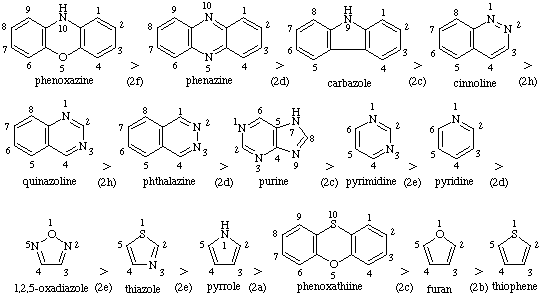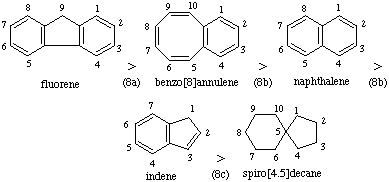Contents of this section
Rule 1
The basic order of seniority of subunits is:
heterocyclic rings and ring systems > heteroatom chains > carbocyclic rings and ring systems > acyclic carbon chainsThe order of seniority of subunits is of primary importance in the generation of polymer names. Further classification according to seniority is based on the nature of the subunits (kind or size or both) and, among identical subunits, (a) on their degree of unsaturation and (b) on their substituents (number, kind and locants). The following criteria are applied consecutively until a decision is reached.
4.1 Heterocyclic rings and ring systems
Rule 2
Among heterocyclic rings and ring systems, the descending order of seniority is:
| a. | a ring or ring system containing nitrogen; |
| b. | in the absence of nitrogen a ring or ring system containing the heteroatom occurring earliest in the order given in Rule 4; |
| c. | a ring or ring system containing the greatest number of rings; |
| d. | a ring or ring system having the largest individual ring; |
| e. | a ring or ring system having the greatest number of heteroatoms; |
| f. | a ring or ring system containing the greatest variety of heteroatoms; |
| g. | the ring or ring system having the greatest number of heteroatoms highest in the order given in Rule 4; |
| h. | of the two rings or ring systems of the same size containing the same number and kind of heteroatoms, the senior system is that one with the lower locants for the heteroatoms. |
Note: This order is a paraphrased extract of that in [ref 11].Examples of the application of seniority rules among different heterocyclic rings and ring systems are (appropriate rule in parentheses):

The order of decreasing seniority within a given heterocyclic ring or ring system is:
| a. | when rings or ring systems differ only in degree of unsaturation, the senior system is the most unsaturated one; |
| b. | when rings or ring systems of the same degree of unsaturation differ in the positions of double bonds, the senior system is that having the lowest locants for double bonds; |
| c. | in heterocyclic ring assemblies, the assembly of highest seniority is that having lowest locants for the points of attachment between the rings within the assembly, consistent with the fixed numbering of the ring or ring system; |
| d. | a ring or ring system with the lowest locants of free valences; |
| e. | a ring or ring system with the largest number of substituents; |
| f. | a ring or ring system having substituents with the lowest locants; |
| g. | a ring or ring system in which the substituent first in alphabetical order has the lowest locant. |

Rule 4
For the most common heteroatoms, the descending order of seniority is:
O > S > Se > Te > N > P > As > Sb > Bi > Si > Ge > Sn > Pb > B > HgRule 5Note: Other heteroatoms may be placed within this order as indicated by their positions in the periodic table [ref 5].
A more substituted single heteroatom is senior to a less substituted single heteroatom of the same kind.
Examples:

Within mono-or disubstituted single heteroatoms, the heteroatom carrying a substituent (substituents) earlier in the alphabet is senior.
Example:

The order of decreasing seniority for chains of heteroatoms of the same kind that have equal length is:
| a. | when chains differ only in degree of unsaturation, the senior chain is the most unsaturated one; Note: This rule applies also to single heteroatoms. |
| b. | when chains of the same degree of unsaturation differ in the positions of multiple bonds, the senior chain is that having the lowest locants for double bonds; |
| c. | the chain with the largest number of substituents; |
| d. | the chain having substituents with the lowest locants; |
| e. | the chain in which the substituent first in alphabetical order has the lowest locant. |

4.3 Carbocyclic rings and ring systems
Rule 8
Among carbocyclic rings and ring systems, the decreasing order of seniority is:
| a. | a ring system containing the greatest number of rings; |
| b. | the largest ring or a ring system with the largest individual ring; |
| c. | a ring system having the greatest number of atoms common to the rings. |
Note: The criteria for further choice are found in Rule C-14.1 in [ref 4].Examples of the application of seniority among carbocyclic rings and ring systems are (appropriate rule in parentheses):

The order of decreasing seniority within a given carbocyclic ring or ring system is:
| a. | when rings or ring systems differ only in degree of unsaturation, the senior system is the most unsaturated one; |
| b. | when rings or ring systems of the same degree of unsaturation differ in the positions of double bonds, the senior system is that having the lowest locants for double bonds; |
| c. | in carbocyclic ring assemblies, the assembly of highest seniority is that having lowest numbers for the points of attachment between the systems within the assembly, consistent with the fixed numbering of the ring or ring system; |
| d. | a ring or ring system with the lowest locants for free valences; |
| e. | a ring or ring system with the largest number of substituents; |
| f. | a ring or ring system having substituents with the lowest locants; |
| g. | a ring or ring system in which the substituent first in alphabetical order has the lowest locant. |



Rule 10
The order of decreasing seniority of acyclic carbon chains of equal length is:
| a. | when chains differ only in degree of unsaturation, the senior chain is the most unsaturated one; Note: This rule applies also to single carbon atoms. |
| b. | when chains of the same degree of unsaturation differ in the positions of multiple bonds, the senior chain is that having multiple bonds with the lowest locants; |
| c. | the chain with the largest number of substituents; |
| d. | the chain having substituents with the lowest locants; |
| e. | the chain in which the substituent first in alphabetical order has the lowest locant. |

4. IUPAC. Nomenclature of Organic Chemistry, Sections A, B, C, D, E, F and H, Pergamon Press, Oxford (1979).
5. IUPAC. A Guide to IUPAC Nomenclature of Organic Compounds, Blackwell Scientific Publications, Oxford (1993).
11. IUPAC. "Nomenclature of fused and bridged fused ring systems 1998", Pure Appl.Chem. 70, 143 -216 (1998).